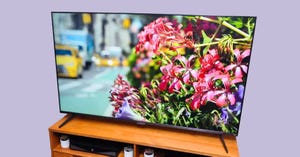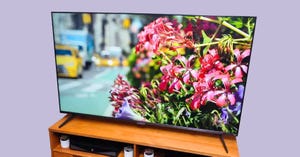
Best 75-Inch TVs for 2023 - CNET
Is bigger always better? In the case of the best TVs, oftentimes the answer is yes. At CNET, our advice is to go as big as you can afford. It can be difficult finding the perfect spot to place a behemoth that’s 75 inches, but if you have the space, the best 75-inch TVs are well worth the price. What makes them even more appealing is that these TVs are now more affordable than ever, often costing under $1,000 or even less during the holiday shopping season.
The list below represents the best TVs I’ve reviewed in CNET’s test lab, where I compare them side by side to see which is most worth buying. I’ve actually reviewed the 65-inch sizes in the series listed below, but the 75- and 77-inch versions are basically identical beyond screen size.
David Katzmaier/CNET
Sizes
55-, 65-, 75- 85-inch
TV Technology
QLED with Mini-LED
Smart TV
Yes (Roku TV)
Resolution
4K
HDMI Ports
4
For the last five years the TCL 6-Series has been our favorite TV for the money, and the 2022 version — also known as the R655 series — is no exception. This TV has an excellent image thanks to mini-LED tech and well-implemented full-array local dimming that helps it run circles around just about any other TV at this price. It improves upon the previous R635 series with improved gaming extras and a new center-mount stand that you can elevate to make room for a soundbar, although the new 85-inch size has standard legs. And finally, the Roku TV operating system is our hands-down favorite.
Note that in addition to the R635, which this TV replaces, other versions of the 6-Series were released in 2021 and remain on sale. The R646 series uses the Google TV operating system but otherwise has similar specifications to the R655 models reviewed here. The R648 series has 8K resolution and is significantly more expensive.
David Katzmaier/CNET
Sizes
42-, 48-, 55-, 65-, 77-, 83-inch
TV Technology
OLED
Smart TV
Yes (webOS)
Resolution
4K
HDMI Ports
4
The C2 represents the pinnacle of picture quality at a price that’s admittedly high, but not too crazy. It beats any non-OLED TV on this list, including the Samsung QN90B below, with its perfect black levels, unbeatable contrast and superb off-angle viewing. It also has superb gaming features, making it the perfect companion to an Xbox Series X or S, PlayStation 5 or both. The C2 comes in a variety of sizes as well, although the bigger models are expensive.
Improvements over the C1 from last year include carbon-fiber construction for up to 47% lighter weight — the 65-inch version we reviewed weighs just 37 pounds with its stand, compared to 72 pounds for the 65-inch C1 — as well as some additional tweaks to game mode and a new “always ready” feature.
Sarah Tew/CNET
Sizes
43-, 50-, 55-, 65-, 75-, 85-inch
TV Technology
LED
Smart TV
Yes (Roku TV)
Resolution
4K
HDMI Ports
3
The picture quality of the TCL 4-Series Roku TV was a step behind the Vizio V-Series in our budget TV test, but the differences between the two are slight enough that you’d really have to have them set up side by side to notice anything at all. The 4-Series lacks the Dolby Vision, Bluetooth connectivity and AMD FreeSync with a variable refresh rate, all of which the Vizio offers.
The 4-Series’ advantage over the Vizio is that it comes with the excellent Roku Smart TV system built in. That makes it a great choice for those looking for a one-stop smart TV solution, without having to add an external streaming device.
David Katzmaier
The Vizio MQX is one of the least expensive TVs to feature full-array local dimming, which lets it reproduce TV shows, movies and games with enough contrast and pop to do HDR justice. The MQX has fewer dimming zones than more expensive TVs like the TCL 6-Series — 42 on the 75-inch size — but that’s more than enough for excellent overall picture quality, with bright highlights, dark black levels, punchy contrast and accurate color.
Unlike the M7 last year, the MQX has a true 120Hz refresh rate, which allows compatibility with 4K/120Hz signals from game consoles like the Xbox Series X and PlayStation 5, and worked well in our tests. Vizio supports both major HDR formats, HDR10 and Dolby Vision, in the M-Series. If you can’t save up for the TCL 6-Series or the Hisense U8H but want a better picture than the 4-Series, the Vizio MQX is an excellent happy medium.
Bobby Oliver/CNET
Looking for a high-end TV with spectacular image quality, but don’t want an OLED? The Samsung QN90B is your best bet. This TV uses QLED TV tech augmented by mini-LED for a brighter image than any OLED TV. The spectacular contrast of OLED still won out in our side-by-side tests, but the QN90B QLED screen comes closer than ever.
David Katzmaier
Among midpriced models we liked the TCL 6-Series just a little better in our side-by-side comparison, but this Hisense is a strong contender. Its excellent image quality is anchored by best-in-class brightness that improves its bright-room picture quality and makes HDR TV movies, shows and games really pop. It’s actually brighter than the TCL with better contrast, but the TCL’s slightly more accurate image gave it the edge overall. The Hisense uses Google TV instead of Roku, and unlike the TCL, the U8H includes an ATSC 3.0 tuner. Frankly, you can’t go wrong with either one.
David Katzmaier
When we compared the best 2022 budget TVs side-by-side, the picture quality of Vizio V-Series clearly emerged as the leader of the pack. The Vizio offered the most balanced and accurate picture during our comparisons, and it comes with some useful extras such as Dolby Vision support, Wi-Fi 6E, Bluetooth compatibility and variable refresh rate for potentially smoother gaming. The biggest downside of the Vizio is its smart TV platform, Vizio SmartCast. It’s crowded, slow and littered with ads for platforms such as Tubi and Kidoodle TV. Even when you factor in the cost of adding a new streaming device, however, the V-Series remains the best overall entry-level TV that we tested.
James Martin/CNET
Samsung is the brand that sells more TVs than anyone, and one of its most popular is the Q60 series. Its sleek QLED screen design stands out compared with the other TVs on this list — even though the ultrathin OLED models are sleeker — and it offers better features, image quality and more sizes than models like the TCL 4-Series and Sony X80K. The TVs listed in this article are all superior values, but if you want a Samsung TV and can’t afford the QN90A, this is a great choice.
Note that the 2021 version, the Q60A, is still on sale and can be cheaper than the Q60B. The newer version measured brighter in our tests, but if you want the best deal, stick with the Q60A if it’s still available.
How does CNET test TVs?
Our TV reviews follow a rigorous, unbiased evaluation process honed over nearly two decades of TV reviews. Our primary TV test lab has specialized equipment for measuring light and color, including a Konica Minolta CS-2000 spectroradiometer, a Murideo Sig-G 4K HDR signal generator and an AVPro Connect 8×8 4K HDR distribution matrix. We Portrait Displays CalMan Ultimate software to evaluate and calibrate every TV we review. In every CNET TV review, three or more similar TVs are compared side by side in various lighting conditions with different content, including movies, TV shows and games, across a variety of test categories, from color to video processing to gaming to HDR. Our reviews also account for design, features, smart TV performance, HDMI input and gaming compatibility and more.
Read more: How We Test TVs
75-inch TV FAQs
Is a 75-inch TV too big?
It depends on your room size, seating distance and personal taste. For a large living room or den, a 75-inch TV is generally excellent, but it’s too big for smaller living rooms or most bedrooms. If you sit closer to the screen you don’t need as large a TV for the best experience. For maximum theatrical impact, according to THX and SMPTE, you should be between 7.5 and 10 feet from a 75-inch screen, although many viewers will find it more comfortable to sit a bit further back than that. Every 75-inch TV has 4K resolution, and if you have 20/20 vision you can sit as close as about 4.5 feet from the screen and still not discern individual pixels.
How wide is a 75-inch TV?
Most 75-inch TVs measure between 65 and 67 inches wide. Because the frames around newer TV screens are typically quite narrow, 75-inch TV widths don’t vary much. Models with very slim frames are on the lower end — the 75-inch Samsung QN90A measures 65.7 inches wide for example, while the slightly thicker-framed 75-inch TCL 4-Series is 66.1 inches wide. If you’re not planning to wall-mount the TV, you generally want the piece of furniture supporting the TV to measure at least as wide as the TV itself, and preferably a few inches wider. Refer to the manufacturer’s website for exact dimensions of a particular 75-inch or 77-inch TV.
How much does a 75-inch TV weigh?
A 75-inch TV weighs between 75 and 100 pounds with its stand, but this varies significantly depending on the type of TV. The TCL 4-Series 75-inch TV weighs 75 pounds with the stand, for example, while the 75-inch Samsung QN90A weighs 98.8 pounds with the stand. Removing the stand — which often consists of a pair of little legs under the panel — allows you to wall-mount the TV and reduces its weight (stands can weigh up to 20 pounds). Shipping weight (box, accessories, etc.) adds another 10 to 20 pounds. Refer to the manufacturer’s website for exact weights of a particular 75-inch TV.
More home entertainment recommendations
- Buying a New TV in 2023
- Best Soundbars for 2023
- Best Streaming Device for 2023
- Best TV Antennas for Cord-Cutters
- Dolby Atmos: Why It’s Cool, How It Works and How to Get It
- Best Sonos Speakers
- QLED vs. OLED: Which TV Tech Should You Buy?
- HDR Formats like Dolby Vision, HDR10, Technicolor and HLG Explained
- Best TVs for Gaming





